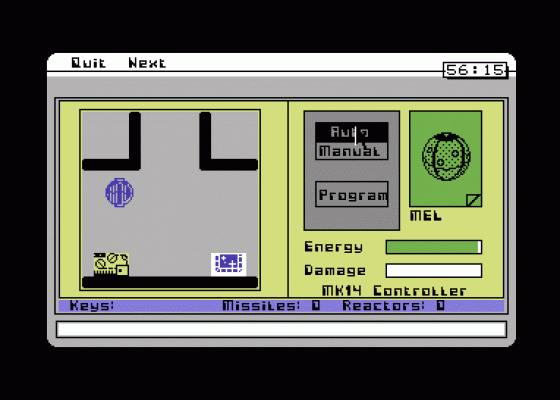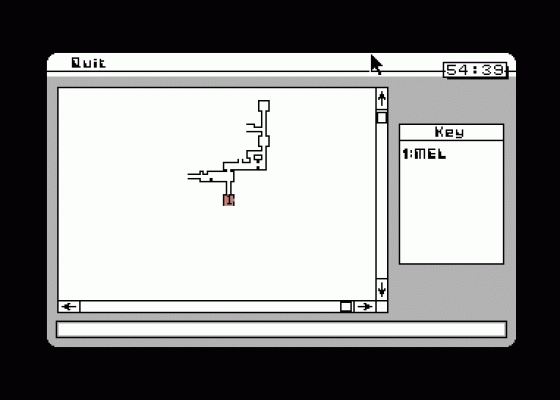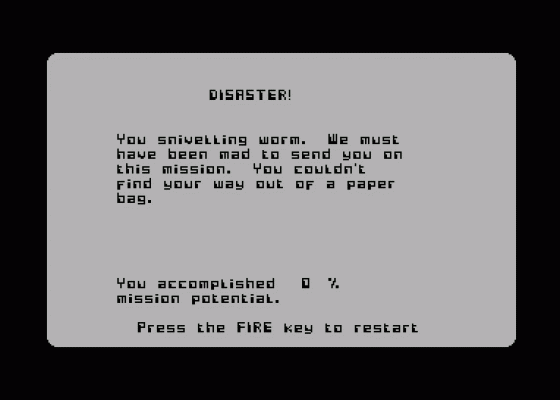
Commodore User
 1st January 1987
1st January 1987
Author: Bill Scolding
Publisher: Mind Games
Machine: Commodore 64/128
Published in Commodore User #40
Mission Omega
The vast alien object known as Omega came from outer space. It came at the speed of light. It threatened the civilisation of mankind. It came without instructions. It appeared to be unplayable.
The crew of the starship Commodore User contacted the Mind Games Star Fleet Command, based in the Argus nebula. Hours later, the reply came back:
C64 MISSION OMEGA HAS SPECTRUM INSTRUCTIONS STOP SOME OF THESE ALREADY IN CIRCULATION STOP WE'RE REPRINTING INLAY CARDS STOP HONEST! STOP

And the Spectrum screenshots on the back of the cassette inlay?
AH... WELL SPOTTED LADS STOP WILL REPLACE THESE WITH C64 PHOTOGRAPHS STOP
So be warned. If you're still thinking of buying this intricate and remarkably tedious game after reading this review, then check the cassette cover first. If it has the old Mind Games address on the back (the Liberty House one) then you'll be well advised to search out another. Otherwise you'll spend more time deciphering the gameplay directions than in playing the game.

The plot is simple. The strange phenomenon, code-named Omega, is going to be blasted out of the ether by the UN spaceships before it collides with Earth. Your delapidated mining ship just happens to be in the vicinity and you're landed with the unhappy task of exploring and hopefully shutting down Omega's reactors. There's the usual ludicrously inadequate amount of time in which to achieve this.
Gameplay, however, is far from simple, instructions or no instructions. Most of the action and strategy is implemented by means of icons and pull-down menus. These are fast, and take a while to get to grips with. I won't bore you with the messy details, but it's mostly a case of moving the arrow and pressing Fire. Quit allows you to leave one screen and move to another.
Exploring Omega is done through remote-controlled robots, curiously misnamed 'androids', and these must first be constructed from the stock of materials, weapons and power units offered on screen. You'll soon find that some weapons and batteries are too heavy to be carried by hover robots and spheres, which are better equipped with small lasers.

Using the icons you gradually build up your task force, which you then have to send out into the Omega maze. Switching to the Control screen, you are faced with three modes of operating each robot. Auto puts the robot on automatic pilot, sending it trundling off down the corridors until it either comes up against a barrier or it has explored as much of the surrounding territory as it can. Subsequent robots can only be operated by Auto if the passageways ahead are not already mapped, so it will be necessary to take them manually to an uncharted region before leaving them to their own devices.
Manual control means just that. You use your joystick or keys to directly manoeuvre the robot, occasionally useful for the reason above, or for switching off the laser screens that block off some corridors. Manual control can also be used when fighting enemy robots, though my robots usually got zapped whether under Auto or Manual control.
And then there's Program in which you scan the road ahead - if it has been mapped - and the send the robot on its way, until it reaches your desired destination.

To the left of the control options is the monitor screen, which gives an overhead view of each individual robot's progress, as it wanders down passageways and into rooms featuring flashing terminals and peculiar hardware (purely decorative, it seems). If you have more than one robot in motion, in different parts of the maze, you can monitor them by flipping the screen.
Selecting the Map icon will show you just how little of Omega has been explored. For once, vast really means vast. The map area depicts the layout of Omega in miniature, and is itself several screens in size. By using the arrow you can pinpoint any area already explored and see it in detail, and the positions of your robots are shown.
If it weren't for the many transporter screens it would be impossible for the task force to explore this enormous area. These transporters, identified by the Otis trade name, can be used again and again, sending you to a different location each time. Fortunately, at least two of the reactors are within spitting distance of a transporter.
The point of all this, in case you've forgotten, is to find and destroy the reactors. Only a missile-carrying robot can shut down a reactor, and as these have a limited range, it is best to locate the reactors using hover robot as scouts, and then follow up with the heavy artillery. Even if you get such a robot to the sight of a reactor, with its missiles intact, it appears that you've got to pick precisely the right moment to fire, and with only fire missiles, and four reactors to destroy, there's no great margin for error.
There's no doubt that, packaging excluded, Mission Omega is a very professional-looking program.
But whichever way you cut it, in the end you come down to the fact that Mission Omega is an elaborate structure built around monotonous and repetitive gameplay.













